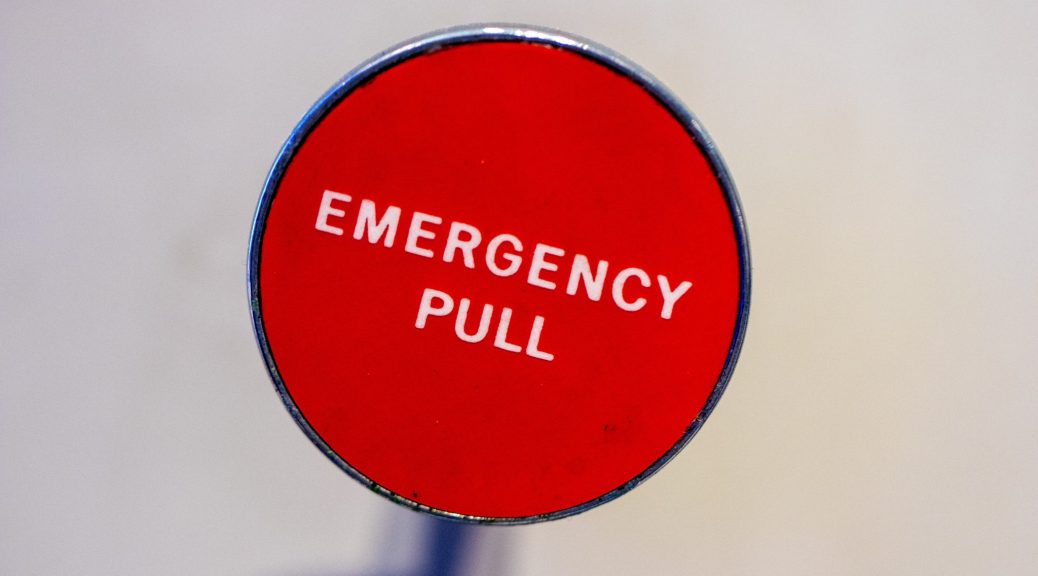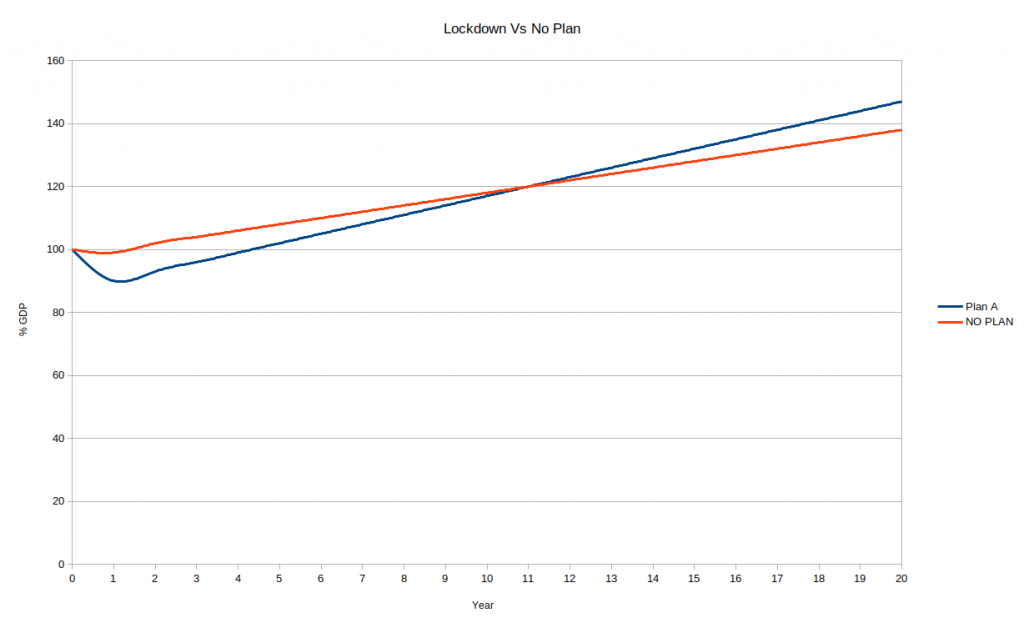
End Game
The world is a terrifying and dangerous place, at least so the saying goes. There are those who would have us believe that daily life is more dangerous today than it has ever been in living history. None of it’s true, of course, and those who would try to convince us it is are almost universally selling right-wing ideology, religion, or newspapers. Occasionally all three.
Those selling as if it were, don’t really need it to be true either. A dedicated following isn’t one that’s prone to checking facts or thinking too critically. To do so can often be seen as a statement of disloyalty or unwelcoming distrust. Simply repeating the phrase it often and loudly enough is all the verification and proof asked and needed for those looking for an excuse to take the message to heart.
The world today is, in fact, safer now than it has been at any point in human history. Both on a local scale and a global view you’re less likely to be murdered, mugged, raped, robbed, shot, or stabbed than at almost any other point in human history.
There’s simply less crime today than there ever has been before; a trend which has continued, with the exception of two world wars, indefinitely. Despite how remarkable the real-life facts behind the rhetoric are, a new metric which enthusiasts call ‘fear of crime’ is trending upwards.
Choosing Metrics
Fear of crime is one of those strange statistics which, looked at critically, means nothing at all and yet still turns out to be staggeringly useful. It appears in countless sources and on the lips of populist politicians worldwide. It’s used to justify a range of initiatives from extra police officers to minority exclusion,.

Crime, it turns out, is an exceptionally useful resource. It’s somehow both universally hated and still a popular topic to rail against. Much like ill health and misfortune, it is universally loathed. Yet, unlike the other two, people are often convinced that politicians who speak out against crime are still saying something meaningful.
In the face of falling crime statistics and changes to circumstance, fear of crime is one of those useful phrases which can remain both truthful and popular while not necessarily meaningful or interesting.
At least some of the utility and interest of the phrase undoubtedly comes from its ability to self-replicate. It’s purpose-built to put both crime and fear right at the forefront of your mind. Why even utter such a nonsense series of syllables if not to incite at least some fear, hate, and a decisive call to action within the intended audience.
Precise Targets
When nebulous phrases are dusted off, dressed, and put on display it almost always means a search for popularity and approval is underway. These can most easily be found in the usual places such as adding money to the NHS and subtracting equal or greater amounts from the unpopular services such as prison and law.
Immigration, one of the best populist targets of bluster and monologue often features at the top of the bill. That it should feature so prominently is an interesting conundrum itself, standing at odds with almost all of the claims and objectives of populist politics.
We know for a fact that immigrant populations are less likely to be involved in crime than the general population. The government’s own statistics show a reduction in crime in conjunction with a rise in immigration[1]. A fascination with immigrations and immigrants is almost entirely at odds with goals and plans which will improve the economy and work towards claimed populist goals.
We know for a fact immigrant groups contribute disproportionately in taxes while drawing comparatively few public resources in contrast to the general population[2]. Yet, almost all of us have suffered through the monologues of those who would stare down the barrel of a camera, opinion piece, or editorial and tell us the opposite is true.

These ‘opinions’ can be categorised into few groups. It can often, for example, be attributed to ‘Wishful thinking’ amongst the uneducated, bigoted, and terminally dim. A surprisingly large number simply do not want to know the difference if it does not fit with a prejudged narrative. If you want and believe something to be true hard enough, you can act as if it is.
There is also no small amount of wilful ignorance amongst those whose opinions and point of view is open to being bought. More than a select few ‘journalists’ are willing to speak out in opposition to facts and science in favour of pandering to a base of support. Whether they too believe some, any, or all of the opinions they promote will be a point forever up for debate.
‘Ignorant ignorance’ there are, of course, those who belong solely in the intended audience of the first two groups. Those too dim-witted, too lazy, or too feckless to think critically about anything at all. They are idiots, morons, and the ideal base audience for both populists and extremists.
Choice Candidates
It does, of course, seem particularly unsettling that the leaders of both the UK and US governments appear to make up a bizarre collection of all three. Both groups certainly disregard scientific advice with an abandon usually reserved for cult groups, fanatical preachers, and morons.
At least the government of the smaller of the two nations has the dignity and awareness to lie to the population and perhaps each other about their intended direction and course of action. In the early days of the response to COVID-19, the country was repeatedly told the government was dedicated to ‘following the science’ in guiding the correct strategy and best course of action.
It was one more woolly phrase designed to elicit applause, admiration, and very little else. Whose science it was they were following was not described either at the time or later since. The World Health Authority and Centre for Disease control both had vastly different suggested paths to the one(s) taken. If it was the science of either organisation or both that was being followed, it was done with staggering incompetence—even by current standards.
Yet, remarkably, this seemed to barely register on the scale of related disasters. In stark contrast to the way both governments typically prefer to ramp up fear and distrust, both came out with a strong message, about 4-6 weeks after a decisive response was due. Their message was clear, no reason for panic or alarm, little needed to be done to combat an ‘overblown’ and ‘overhyped’ threat.
For those paying attention, it was in that moment that alarm bells began to ring out.
Responding In-Kind
While the UK championed a response which appeared to come from gut feeling and raw instinct, the US appeared to champion an approach of anti-science and ignorance. The response from the office of the prime minister promoted advice which seemingly went against the WHO and medical expertise. The office of the president of the United States promoted advice which went against all good sense.
The President appeared to degrade from an already poor position of advising untested, unproven, and ill-advised pharmaceutical Hydroxychloroquine. More recently, the staggeringly ignorant world leader has doubled down several times over by abandoning pharmaceuticals and advocating for injections of disinfectant instead.
The social media world was forced into overdrive to insist the orange man had said something—anything at all—sensible that was being contorted by ‘fake news media’™. An alternate, reasonable, or even sane reading of the president’s words is yet to be produced.
The bizarre ranting rhetoric had more in common with the ramblings of a dementia patient than a standard presidential address. If the man seemed outwardly capable of ingesting or understanding the stress of the job it might be suggested that the role was negatively impacting his well-being in a large way. As it is, the advice handed out is only marginally more mad that the ramblings and rhetoric which put him in office.
Forward Planning
It is distinctly troubling that this unhinged monologue comes the man who claims to be in charge of precisely when and how the US extricates itself from the crisis. A role and objective which is neither simple, straightforward, or without severe pitfalls and traps.
Yet even there, the president has voiced support for the small subsections of the religious and ignorant who have protested the very ideas of lockdown and the insult to ‘freedom’ that it represents. Here we find more in common with both sides of the Atlantic than we’d like to admit.
Both countries have seen the rapid rise in the voices of both the willfully ignorant and terminally dim. In the anything-goes social media age, the stupid and the uninformed are more emboldened than ever and they are currently calling for an immediate halt to virus mitigation efforts. The most common cry calls for a return to business as usual in the name of ‘freedom’, the economy and often both.

Aside from the legal and ethical conundrum which governs whether or not we do have the freedom to kill a subset of our population; the economic arguments alone hold little water under even glancing scrutiny.
The lockdown must cease immediately, the argument goes because we can not afford for it to continue any longer.
Giving these groups the benefit of the doubt, we can assume they mean to say that it is uncomfortable, inconvenient, or unenjoyable and would feel ridiculous just saying-so. The alternative is a failure of maths, reason, and sense which lands serious accusations at the feet of our education system.
Healthy Economics
The lockdown is, without a doubt, a staggeringly expensive project. The UK’s £350 billion to date and the US $2 trillion packages would be roughly enough to begin populating Mars. Though it’s still only distant second to the largest financial bailout the UK has produced. £500 billion was distributed amongst the major financial institutions of the world in 2008 after the results of gross greed and negligence came to inevitable fruition.
The bailout figures of both countries today count for approximately 10% of their respective GDP. Both equate to around $6000 per head. Though the distribution model of both leaves a lot still to be desired.
In the US, distribution of funds is a single one-time cheque of $1200 being sent to citizens. The remainder of the $6000, as best as can be told, is being distributed amongst corporate welfare programs instead. The cheques, seemingly at the insistence of the president’s office, bear Trump’s name in bold type.
You could scarcely imagine a more apt physical representation of being bilked than an under-value cheque bearing the slogan of the president’s upcoming election campaign.
In the UK, similar programs have been designed to distribute cash amongst employers to keep businesses open and pay salaries while keeping employees at home. While infinitely more sensible than the US program, the UK does at least achieve many of the aims of lockdown. Some of the deserved criticisms, however, point out that the initiative still ignores large numbers of self-employed business owners and leaves much of the power in the hands and the discretion of employers and their interests.
Aims And Goals
The projects of both countries exist to keep businesses alive long enough to open their doors again and continue operating. The importance of both, to not only the economy but the people who depend on their own business, can not be overstated.
The immediate hit, a 10% contraction in the economy is an enormous blow but consider too the alternative. A complete reversal of the lockdown, a re-opening of business and a resumption of business as usual first thing Monday morning.
Most business would be more or less capable of resuming where they left off, the economy would recover to more-or-less normal levels in an ideal scenario. The virus would too.

In this scenario COVID-19 would run unchecked through the country, killing about 3% of the population and around 1-2% of economically active. Putting aside the impact of overburdened healthcare and the deaths added as a result, we should expect at least 1% of the working population to be permanently removed from the economy. Those with an understanding of compound interest have likely clued in by now.
That 1%, a conservative figure if there ever was one, is a destruction of the economy which we feel year after year for decades to come. While avoiding a large temporary hit, that 1% is a 1% reduction this year, next year, the year after, and the year after that. In two decades that 1% reduction making a temporary 10% impact look comparatively gentle.
By returning to immediate business as usual, not taking the temporary hit, and effectively euthanising 3% of the population we would condemn our own economy to far greater impact than the temporary 10% which allows recovery in the weeks and months which follow the pandemic.
As is true of much of the bluster that comes from extremists and their mouth-pieces, the bluster and conjecture of the far-right is just that and nothing more when it comes to the economic arguments. In their case, it’s unjust and learnt experience not to give them the benefit of the doubt.
They, almost certainly, do know better and either don’t care or act with malice intent. It is, at best, a desperate bid to remain relevant, current, and against the grain in exceptionally challenging times.
With individual states rapidly reopening on a state-by-state basis and momentum gathering to end the COVID-19 response, it looks like the minority working to achieve it can get their wish after all.
Lost Opportunities
The $2 trillion spent on curbing the spread of the virus and limiting its effect has bought time that looks like it may well be squandered for nought. A return to business in the coming days and weeks will allow a continued spread which will continue seemingly unchecked through the population.
Countries who implemented drastic and early lockdown to contain numbers are re-opening and returning to business cautiously and slowly to keep numbers low. That early and drastic economic hit has paved the way to return to business and get their countries cautiously moving again.
Neither the US or UK exists in that group. In the UK, at least, talk of return to normal is still muted in favour of lowering numbers and controlling spread. The US looks to be going in another direction. The chances look strong that the country will reopen, either in full or in large part, with catastrophically high numbers of infected citizens.

The $2 trillion spent will have bought about 4 weeks of extra-time and absolutely nothing else. The US seems to be buying its way into a worst-of-both-worlds scenario by sacrificing 10% of its economy and the lives of its people too.
At the heart of the reopening is an ‘alternative’ media telling the population the world is no longer terrifying or dangerous. The same sources that proclaimed danger and fear at the end of 2019 are dedicated to how safe we are in 2020. COVID-19 has seen fake cures, phoney treatments, and voodoo economics on a scale the late ’90s could have only dreamed of.
The first pandemic in the age of social media has seen a viral spread of misinformation which has run alongside and almost mirrored the pace and scale of the physical virus completely. Like the physical virus, the social media counterpart seems to have been caught by those in elected office too.
Those of us optimistic about the internet, social media, and its power over a decade ago might have thought its power in such scenarios would defeat global pandemics easily. We often marvelled at its effect on spreading democracy and free speech to every corner of the planet. In both cases, we seem to have created tools and technologies far worse than the disease itself.
[1] Bell, B., F. Fasani and S. Machin. “Crime and Immigration: Evidence from Large Immigrant Waves.” Review of Economics and Statistics, forthcoming 2013.
[2]Bell, B., F. Fasani and S. Machin. “Crime and Immigration: Evidence from Large Immigrant Waves.” Review of Economics and Statistics, forthcoming 2013.